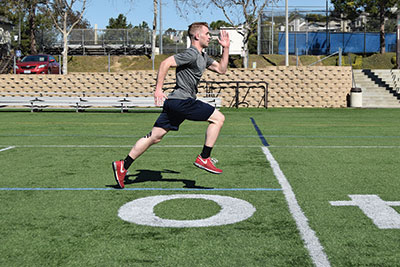Sprinting for Jiu-Jitsu
Often overlooked for more stylish exercises like battle ropes and kettlebell swings, sprinting has a list of useful benefits that can help any jiu-jitsu player. Whether you’re a hobbyist or active competitor, sprinting will improve your conditioning, body composition, and mental toughness. It has been shown to improve the efficiency of the heart and lungs, benefit the circulatory system, and can actually improve your endurance. In fact, sprinting is one activity that all humans can benefit from, regardless of goal, and best yet, no equipment or gym membership is required. Just find some open space, lace up your running shoes, and get ready to reap the rewards of some hard sprint work.
Understanding the Energy System
Jiu-jitsu is a demanding sport that requires all of the body’s energy producing mechanisms. The body makes energy by breaking down ATP (Adenosine Triphosphate) through three systems: the Phosphagen System, Glycolytic System, and Oxidative System. The first two might be the most important for grapplers, and involves supplying the energy for short-term explosive movements lasting one to ten seconds via the Phosphagen System, and slightly longer bursts lasting ten seconds to two minutes through the Glycolytic System. We’ll spare you the boring science talk, but realize these systems are extremely important for performing jiu-jitsu type movements and can be trained and conditioned through short and moderate duration sprints.
Improve Your Conditioning
One of the best reasons to add sprinting to your exercise routine is to improve your conditioning. Even the best-trained elite black belts need to develop and progress their conditioning, and sprinting has been shown to improve lung function and maximum oxygen uptake. This means sprinting will improve your lungs ability to take in oxygen and expel carbon dioxide, as well as how much oxygen you can take in. When you’re having a hard roll, your muscles, brain, and body are in immediate need of oxygen, and the ability to take in more will delay the time for you to fatigue.
Sprint work also improves the efficiency and rate at which your body can recover those previously mentioned energy systems. Through various sprint protocols, you can train specific energy systems like the Phosphagen and Glycolytic Systems, along with your heart’s ability to recover. Being able to recover quickly means you’ll have the energy needed late in a match to impose your game and hopefully win the fight. In turn, sprinting, in combination with the aforementioned factors, will increase your overall endurance by improving the ability of the body to remove waste products. It may seem counterintuitive, however, short and moderate sprints will expand how long your body can endure physical demands.
Improve your Body Composition
Athletes can also use sprint work to increase muscle, lose fat, and cut weight for an upcoming competition. Sprinting has been shown to burn more fat than steady-state running and at a faster rate. So if you need to cut weight fast, adding sprints to your routine will serve you better than long, slower-paced runs. Additionally, sprinting has been shown to burn fat without burning muscle. In fact, sprints will increase leg muscle while targeting your fast twitch fibers, which will make you quicker and more powerful. Sprints also improve your mental toughness and are more time efficient than other forms of conditioning.
Sprint Variations
Sprinting can do a lot to improve your conditioning and body composition; however, it can also put stress on your joints and aggravate nagging injuries if you’re not careful. For many of us, it may be easiest to hit the pavement, but this is the hardest on your joints and can cause issues over time. If you have access to a beach, sprinting in the sand is more forgiving on your joints, requires less in terms of recovery the next day, and actually burns more calories. Running on grass or turf will also have less impact on the joints, as will running up hills, which is also more challenging and will deliver greater benefits in less time. If running is not your thing, similar benefits to running sprints can be had from cycling, swimming, rowing, and sled pushes, which are all also easier on the joints.

Maintain tall, upright posture, and attempt to strike the ground with your foot directly below your body when upright.
Tips On Technique
• Keep your arms bent at 90 degrees at all times.
• Drive your elbows hard backward and forward to maximize speed and stride length.
• Keep your chin up, not too high, and not tucked, which will affect your breathing.
• Keep relaxed shoulders and do not allow them to shrug upward.
• Keep your hands open, wrists straight, and drive your arms straight ahead, never across your body, which will slow you down.
• Your foot should land underneath your body when upright, and not in front of you.
• Keep your core tight throughout the length of the sprint and maintain good, tall posture.










